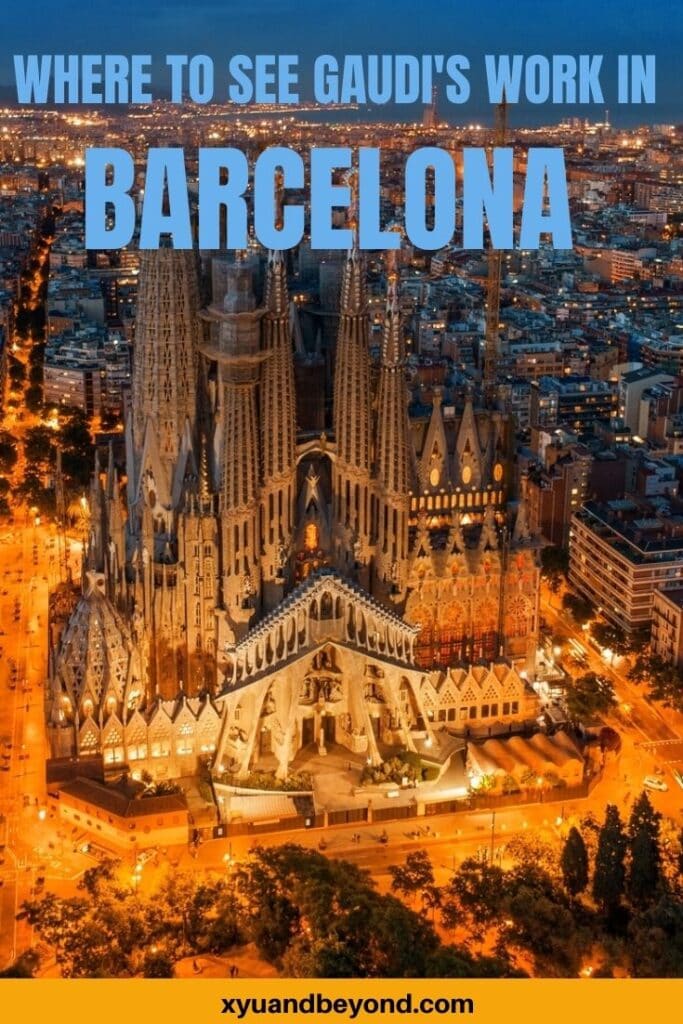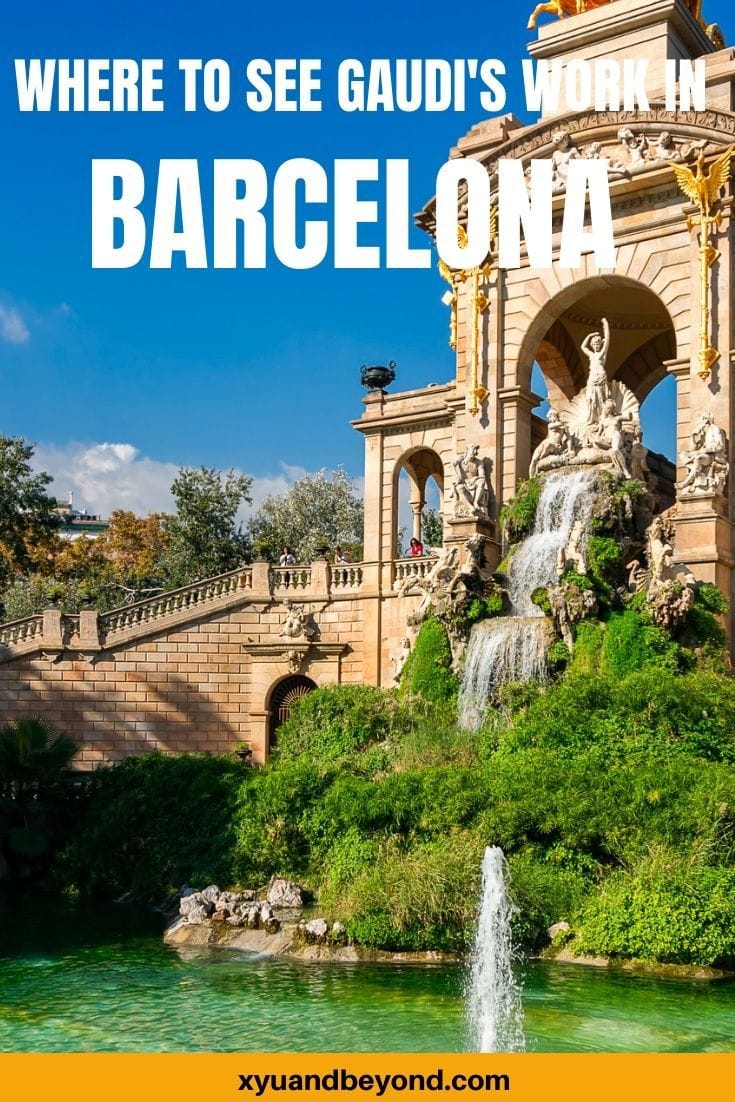Ultimate Guide to the Best Antoni Gaudi Sites in Barcelona
Barcelona and architect Antoni Gaudí are synonymous and you can’t think of one without thinking of the other. Architect and designer, Antoni Gaudí was a pioneer of the Art Nouveau architectural style and his works are scattered throughout the city. His work connected art to an organic style influenced by nature and its forms. In the mid-1800s, Gaudí came to represent Barcelona’s interpretation of Art Nouveau which was called Modernism.
Gaudi’s work in Barcelona led to the creation of some of the city’s most extraordinary landmarks no trip to Barcelona is complete without visiting some of these stunning buildings designed by Gaudi. Gaudí broke new ground within the architectural field by using texture and colour in his works that had never been imagined before. There is no better time to explore Barcelona in winter when the crowds are lowest and the city is lit up for the winter season and Christmas.
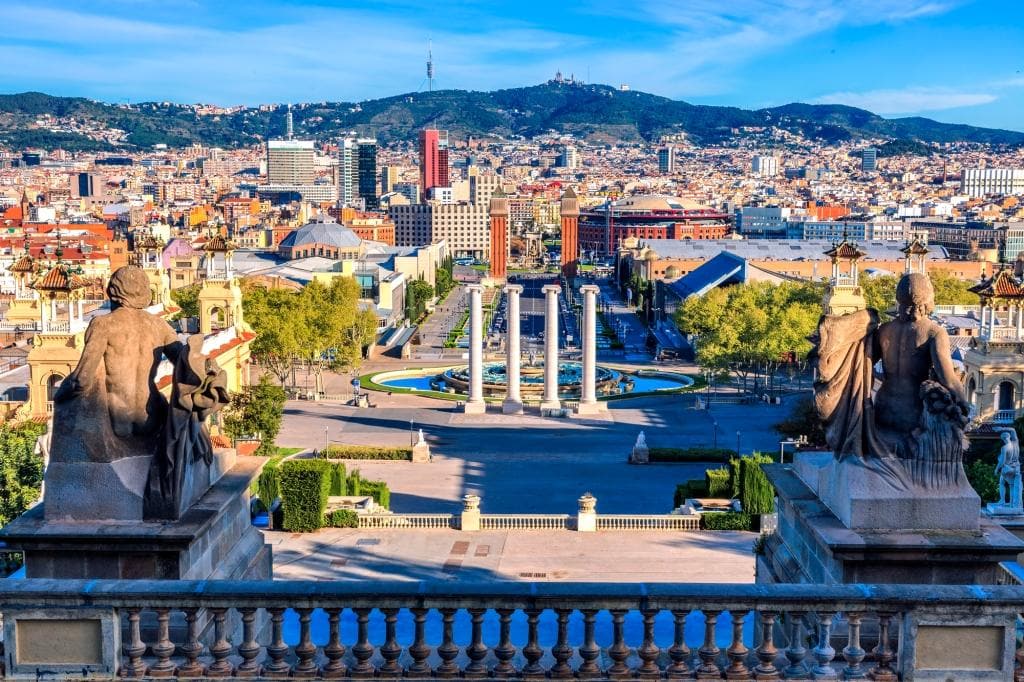
I didn’t get to spend a lot of time in Barcelona, only one day to be honest, but what I did manage to see of Gaudi’s works was awe-inspiring. I plan to return to Spain as I adore Spanish food and have to see more of the country. I have been to Mojácar One of Spain’s most beautiful white villages and the Almeria Coast and managed to visit the Alhambra but this country has so much to offer the traveller it’s time to go back and spend more time there. Finding the best Gaudi sites in Barcelona Spain has been a bucket list item of mine for many years.
If you are only visiting for one day you obviously won’t need accommodation but if you are looking for the best place to stay to extend your trip one of the best areas to stay in Barcelona to view Gaudi buildings is Eixample. This area covers a wide range of Barcelona attractions including the La Sagrada Familia.
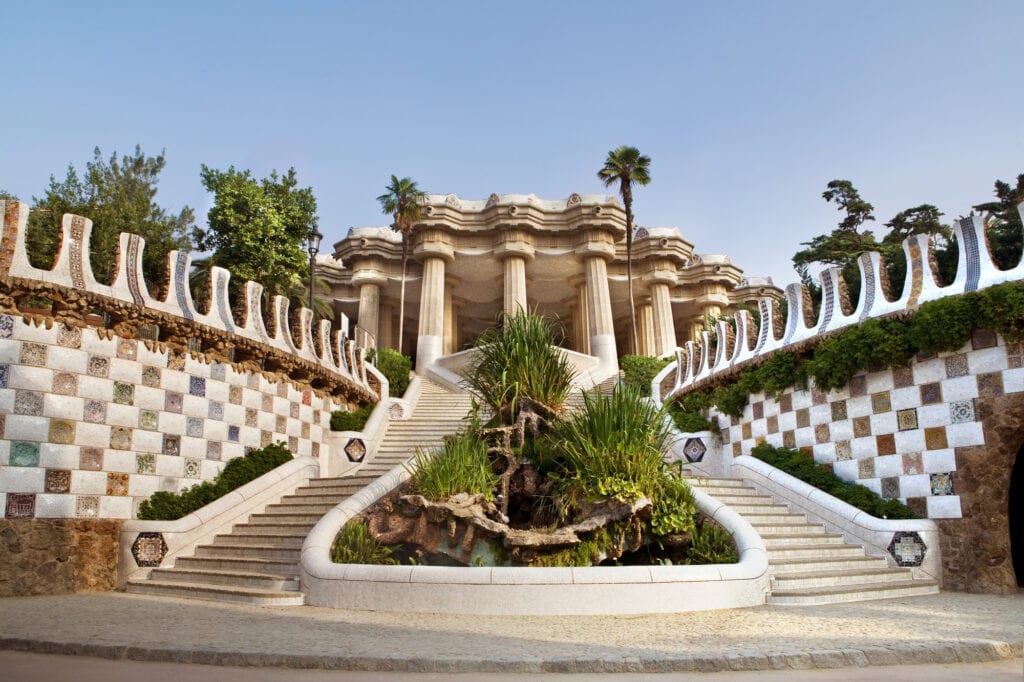
Which Gaudi works are World Heritage sites – UNESCO listed?
Gaudi’s “exceptional creative contribution” has been recognised by UNESCO, with a total of seven of the Gaudi buildings being listed as UNESCO World Heritage sites. The responsibility for Gaudi’s work is owned by various individuals and governmental bodies. Park Güell is owned by the Barcelona City Council, Palau Güell by the Barcelona Provincial Council, Casa Milà-La Pedrera by the Fundació Catalunya – La Pedrera, and Casa Vicens is private property. Casa Batlló is owned by Inmobiliaria Casa Batlló SL, Sagrada Família by the Board of the Sagrada Família, and the Crypt of the Colònia Güell by Colònia Güell Consortium.
- Park Guell
- Palau Guell
- Casa Mila
- Casa Vicens
- La Sagrada Familia
- Casa Batllo
- Crypt in Colonia Guell.
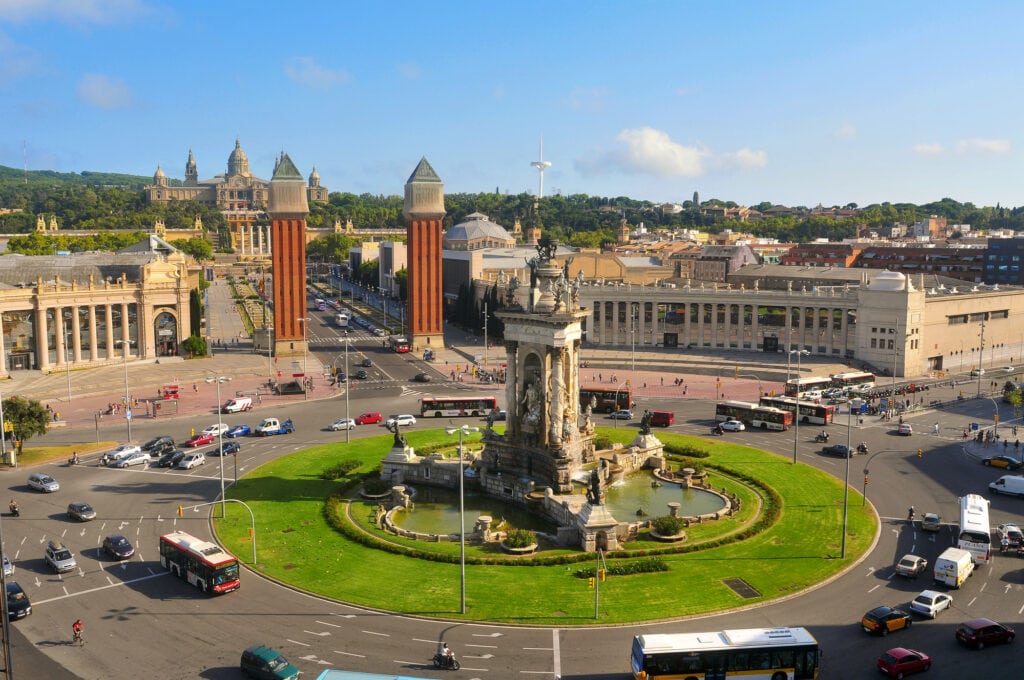
- Ultimate Guide to the Best Antoni Gaudi Sites in Barcelona
- Which Gaudi works are World Heritage sites – UNESCO listed?
- FAQ on 23 Gaudi Buildings in Barcelona
- 1. What are the most famous Gaudi buildings in Barcelona?
- 2. How many Gaudi buildings can be found in Barcelona?
- 3. What is the architectural style of Gaudi buildings in Barcelona?
- 4. Which Gaudi building is a UNESCO World Heritage Site?
- 5. What is the significance of Gaudi's work in Barcelona?
- 6. How can I explore Gaudi buildings in Barcelona?
- 7. What makes Gaudi buildings in Barcelona so unique?
- 23 Antoni Gaudi buildings in Barcelona
- Casa Vicens
- College of the Teresians
- Casa Calvet
- Casa Milá – La Pedrera
- Palau Guell
- Sagrada Familia a UNESCO World Heritage Site
- Sagrada Familia school
- Cascada Fountain at Parc de la Ciutadella
- Gaudi Street Lamps – Plaça Reial and Pla de Palau
- Torre Bellesguard (Casa Figueres)
- Street Tiles – Passeig de Gracia
- Gaudi Factory of Mataro
- Finca Miralles Gate
- Güell Pavilions
- Park Guell
- Casa Batlló
- Church of Colònia Güell – The Crypt
- Church Sant Pacià – Mosaic of Gaudí
- Gaudi Museums
- Gaudi House Museum
- Gaudi Exhibition Centre
- Gaudi Experience
- National Museum of Catalan Art
The Barcelona city pass will give you access to several of Gaudi’s most famous buildings along with free bus tickets to get to the sites.
FAQ on 23 Gaudi Buildings in Barcelona
1. What are the most famous Gaudi buildings in Barcelona?
In Barcelona, some of the most famous buildings by Gaudi include Sagrada Familia, Casa Batlló, La Pedrera, Park Güell, and Casa Vicens.
2. How many Gaudi buildings can be found in Barcelona?
There are a total of 23 Gaudi buildings in Barcelona city, showcasing the architectural genius of Antoni Gaudí.
3. What is the architectural style of Gaudi buildings in Barcelona?
The Gaudi buildings in Barcelona are known for their unique style which blends elements of Art Nouveau and Modernista with Gothic and Catalan influences, creating a distinctive modernist masterpiece.
4. Which Gaudi building is a UNESCO World Heritage Site?
The Sagrada Familia is a UNESCO World Heritage Site and is one of the most iconic Gaudi sites in Barcelona, attracting millions of visitors each year.
5. What is the significance of Gaudi’s work in Barcelona?
Antoni Gaudí is considered one of the greatest architects of all time, and his buildings in Barcelona have become major attractions that contribute to the city’s cultural heritage and allure.
6. How can I explore Gaudi buildings in Barcelona?
You can explore the Gaudi buildings in Barcelona by visiting popular sites such as Park Güell, Casa Batlló, and La Pedrera, or by taking guided tours that showcase Gaudí’s work throughout the city.
7. What makes Gaudi buildings in Barcelona so unique?
The Gaudi buildings in Barcelona are renowned for their stained glass and Gaudí’s style of architecture drew heavily from nature, incorporating organic shapes and forms into his architecture. His designs mimic natural elements such as plants, animals, and geological formations. Antoni Gaudí is one of the most renowned figures in the Modernist (or Modernisme) movement in architecture, particularly in Catalonia. His work exemplifies the characteristics and innovations of Modernist architecture while also pushing its boundaries with his unique personal style.
23 Antoni Gaudi buildings in Barcelona
Antoni Gaudi buildings in Barcelona are a must-see for anyone visiting Barcelona. With a total of 23 Gaudi buildings in Barcelona, including iconic landmarks such as La Rambla and Palau de la Musica, the city is a treasure trove of Gaudi sites. Recognized as world heritage sites by UNESCO, these architect’s masterpieces showcase Gaudi’s Barcelona at its finest. The Barcelona City Council awarded the Gaudi experience with the creation of Gaudí Barcelona, a route that highlights the best spots in Barcelona designed by Gaudi. Whether you’re on a Barcelona itinerary or simply taking a day trip to Barcelona from outside Barcelona, a visit to Barcelona is incomplete without exploring the enchanting Gaudí in Barcelona.
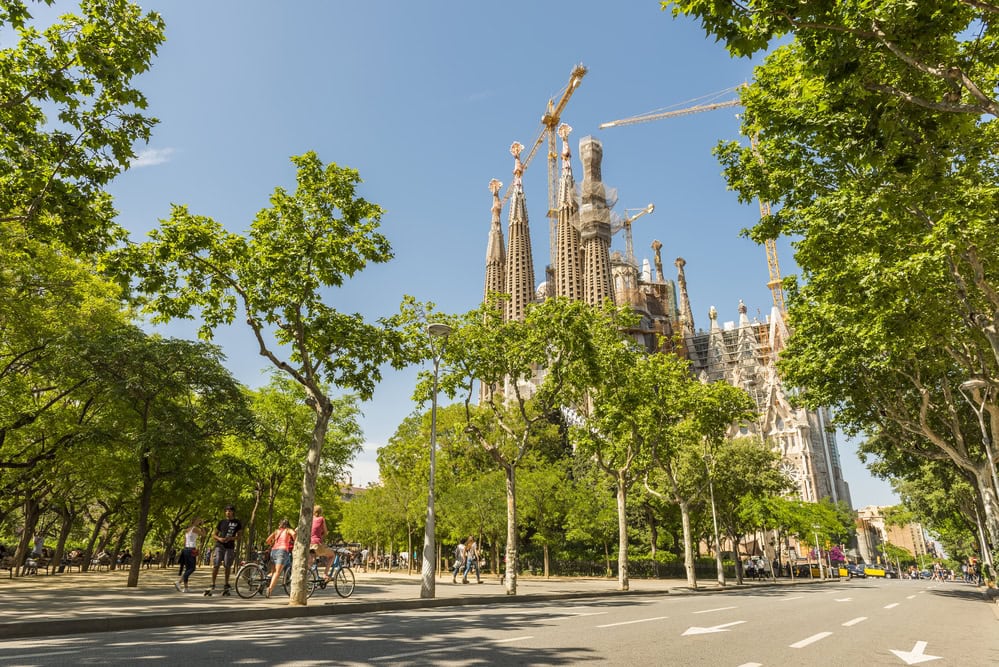
From the Barcelona Forum to the Garden of the Hesperides, there is no shortage of attractions in Barcelona that showcase the genius of Antoni Gaudí in Barcelona. Discover the magic behind 23 Gaudí buildings throughout the city, each one a unique masterpiece that represents the architect’s innovative vision. Immerse yourself in the Gaudí Barcelona experience and witness the beauty of Gaudí’s Barcelona come to life in these awe-inspiring structures. Plan your trip to Barcelona tourism and explore the rich cultural heritage of this vibrant city through the lens of Antoni Gaudí in Barcelona.
Casa Vicens
The first building designed by architect Antoni Gaudi in Barcelona was Casa Vicens and in 2005, it was declared a UNESCO world heritage site. Casa Viens is a combination of Hispanic and Arabic traditions called Neo-Mudéjar and oriental style architecture. Casa Viens was one of the first Art Nouveau buildings in the world.

Built between 1883 and 1885, Casa Vicens was the first of Gaudi’s houses in Barcelona and it was a private house that was commissioned by the Industrialist Vicens. It was bought by a bank in 2014 immaculately restored and opened to the public in 2017.
Its colourful beauty is a mix of Art Nouveau mixed with oriental ceramics, with a stunning rooftop terrace and guides on each floor to answer any questions the house is a must-see for Gaudi fans.
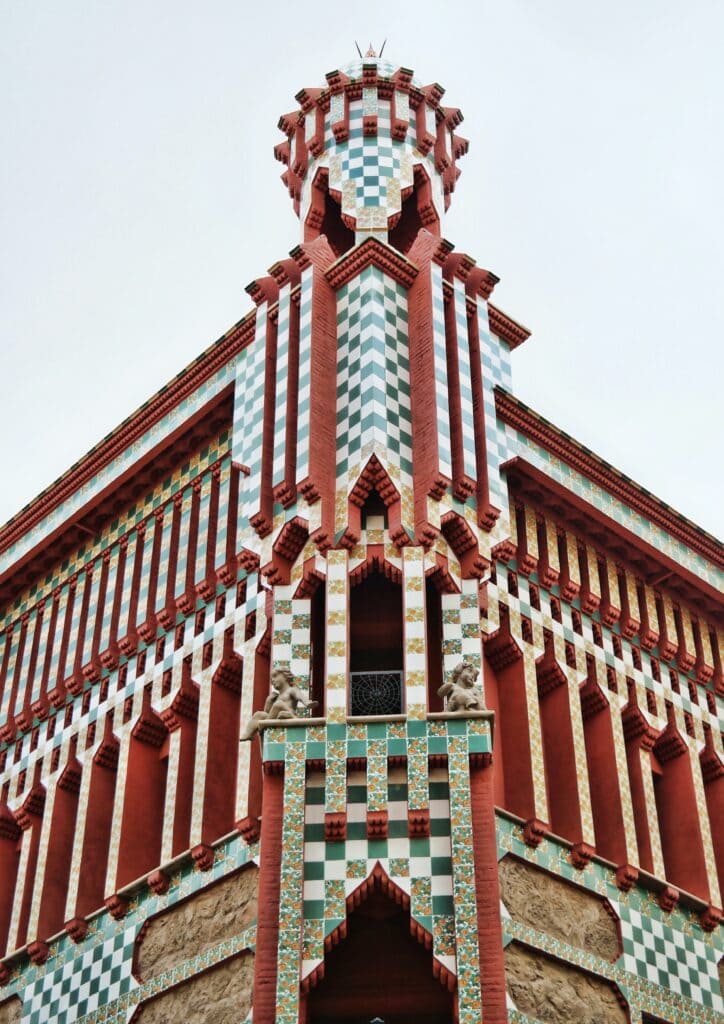
College of the Teresians
This was one of Gaudi’s early works and he took over the building from another architect. It was a very small budget at the time but Gaudi managed to create a stunning work of art. The College is still in operation today so you can’t see inside but you can view the exterior with its gorgeous red brick façade. You will notice just how different this building is from his later works.
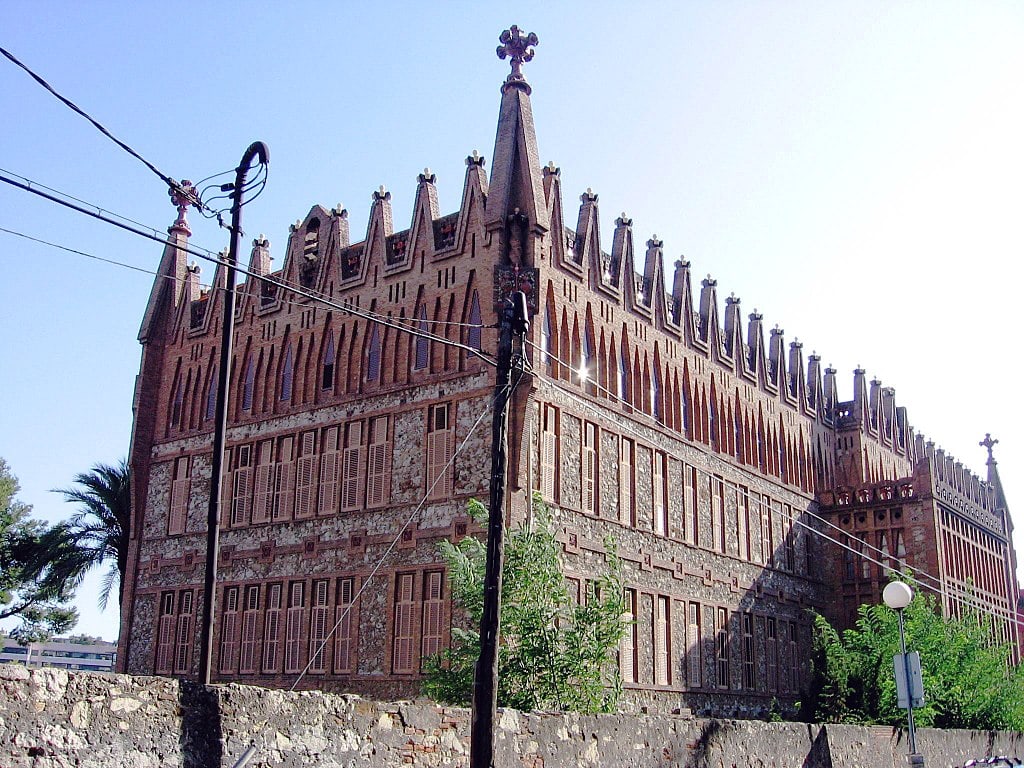
Casa Calvet
Another of Gaudi’s earliest buildings Calvet is probably the most conservative. Another of Gaudi’s earliest buildings Calvet is probably the most conservative. In 1990 Barcelona declared it the best building of the year. You can see the signs of his passion for Art Nouveau within the attic balconies and the curving front of the building.
You can see Gaudi’s nod to the homeowner as this was a building that incorporated both a business and a home. It was squeezed between existing buildings but Gaudi added details like the entrance columns in the form of stacked thread bobbins and the mushrooms on the centre of the oriel which is a nod to the owner’s hobby of mushroom foraging.
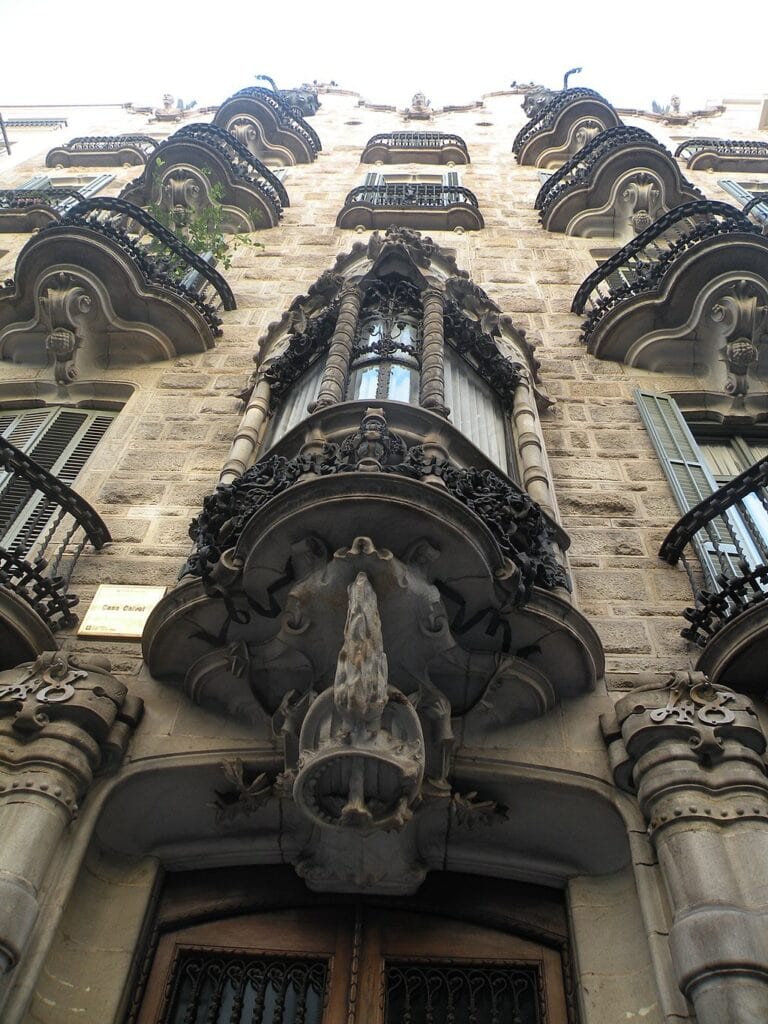
Casa Milá – La Pedrera
This was a home commissioned by Pere Milà and his wife Roser Segimon for their family. The family were going to live on the main floor and rent out the apartments above. In Barcelona, the building is nicknamed La Pedrera or the Quarry.
Casa Mila is one of Barcelona’s most interesting buildings. It is called Le Pedrera because the building features forms drawn from nature with curved balconies and a finish of rough plaster that resembles a stone quarry. It was called this because of the rough-hewn texture of the building.
La Pedrera is also the only Gaudi interpretation centre in Barcelona and is must visit if you want to learn more about Gaudi and his work in Barcelona.
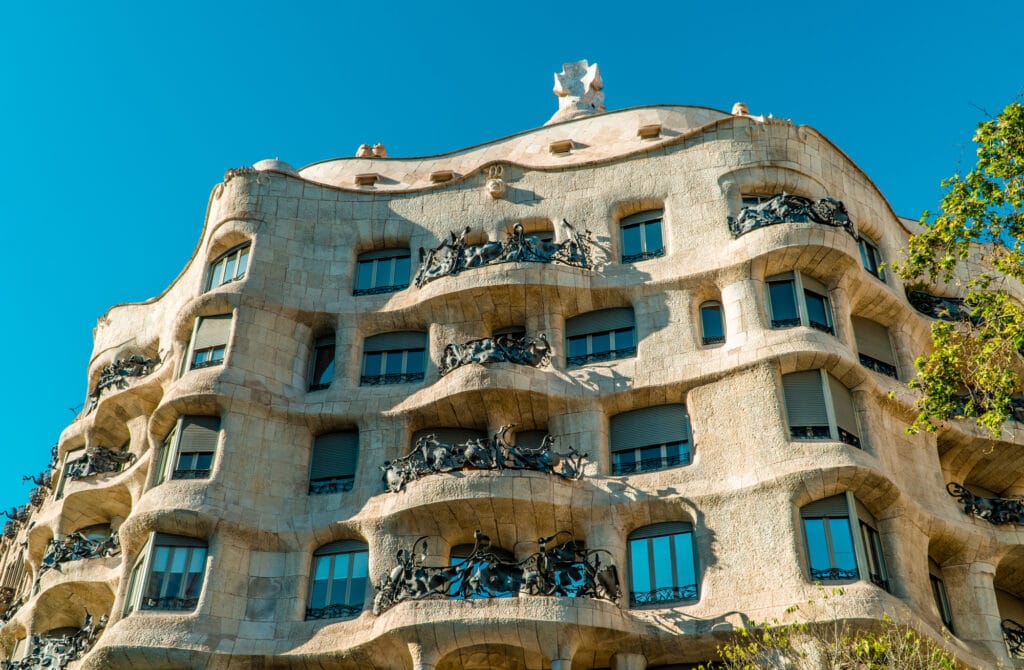
Palau Guell
The Palau Güell is one of the first important commissions that Gaudí undertook at the beginning of his career. Eusebi Güell wanted Gaudí to build him an urban palace as an extension of the family house he had on the Rambla de Barcelona.
The Güell Palace is considered one of the best Gaudi buildings in Barcelona and is on the UNESCO World Heritage list.
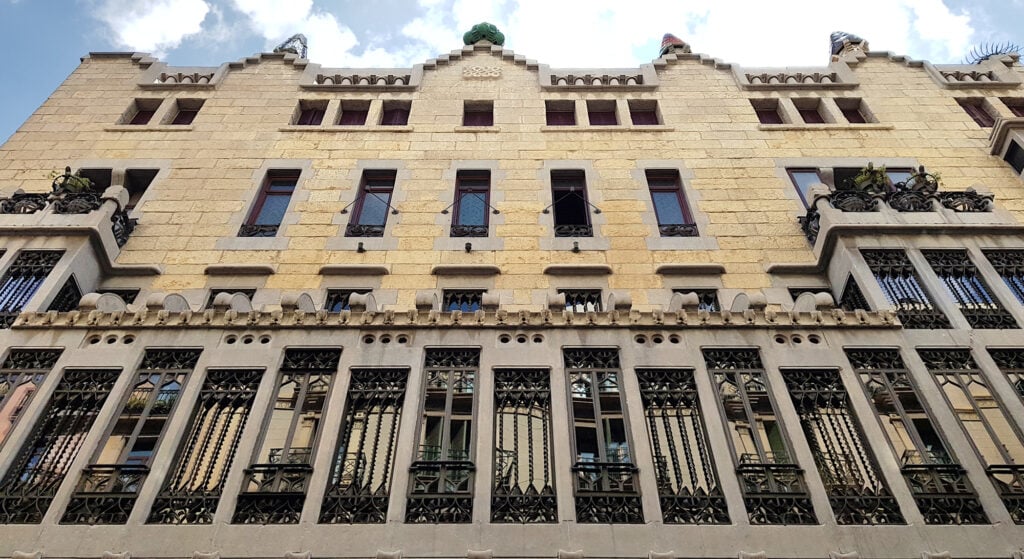
Reminiscent of a Venetian palace and built to entertain the wealthy and titled of European society the guests would enter through the front iron gates, which feature forged ironwork that resembles seaweed and a parabolic arch.
The sumptuous walls and ceilings of the receiving room hid small viewing windows where the owners of the home could view their guests from the upper floor and get a “sneak peek” before greeting them.

The main entertaining room has a tall ceiling with small holes near the top where lanterns were hung at night from the outside to give the appearance of a starlit sky.
Sagrada Familia a UNESCO World Heritage Site
If you haven’t heard or seen the Sagrada Familia anywhere in the media – where have you been? This is the most iconic building in Barcelona and one of the 7 UNESCO sites in Barcelona. The Sagrada is still under construction to this day and is expected to be finished in 2026.
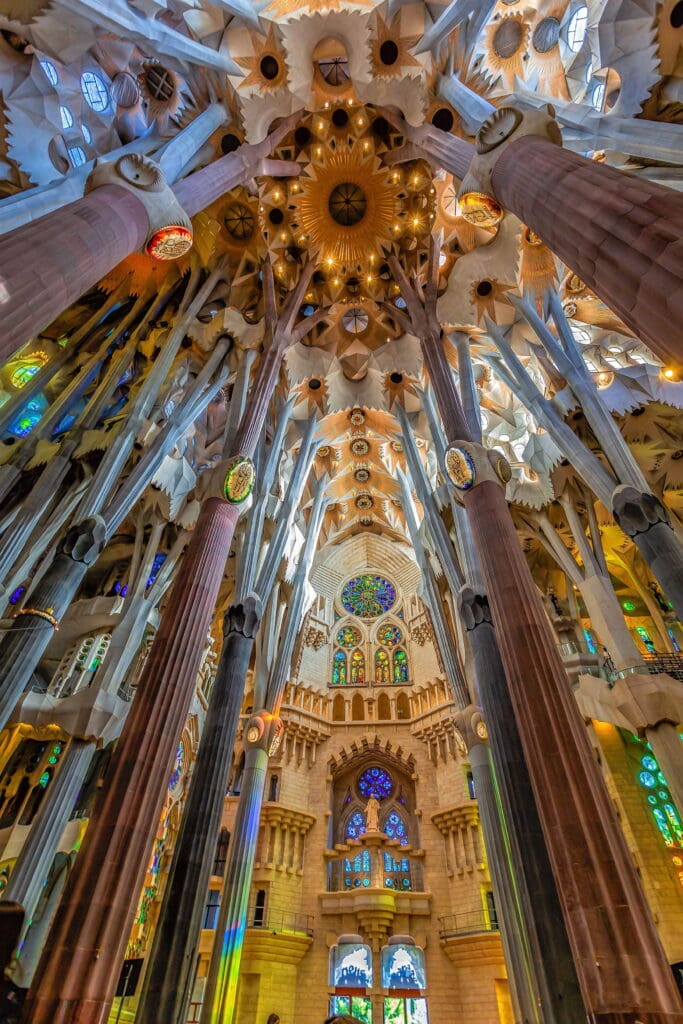
This jaw-dropping building is the height of Gothic and Art Nouveau and is distinctly Gaudi style, but he never finished the building due to his being killed in a traffic accident in 1926. Gaudi is interred in the Crypt of the Basilica.
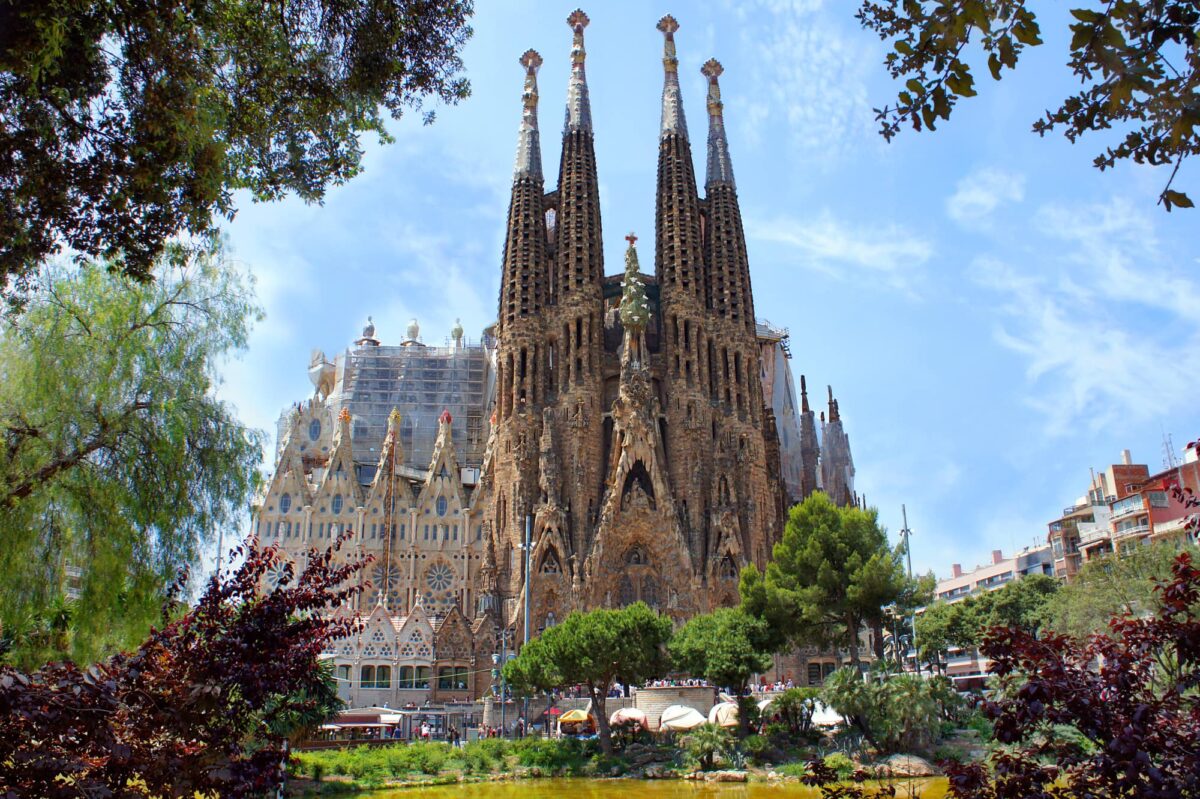
The Sagrada Familia brings in over 3,000,000 million visitors to the building each year. It is simply an outstanding architectural gem with its decorations and stained glass windows.
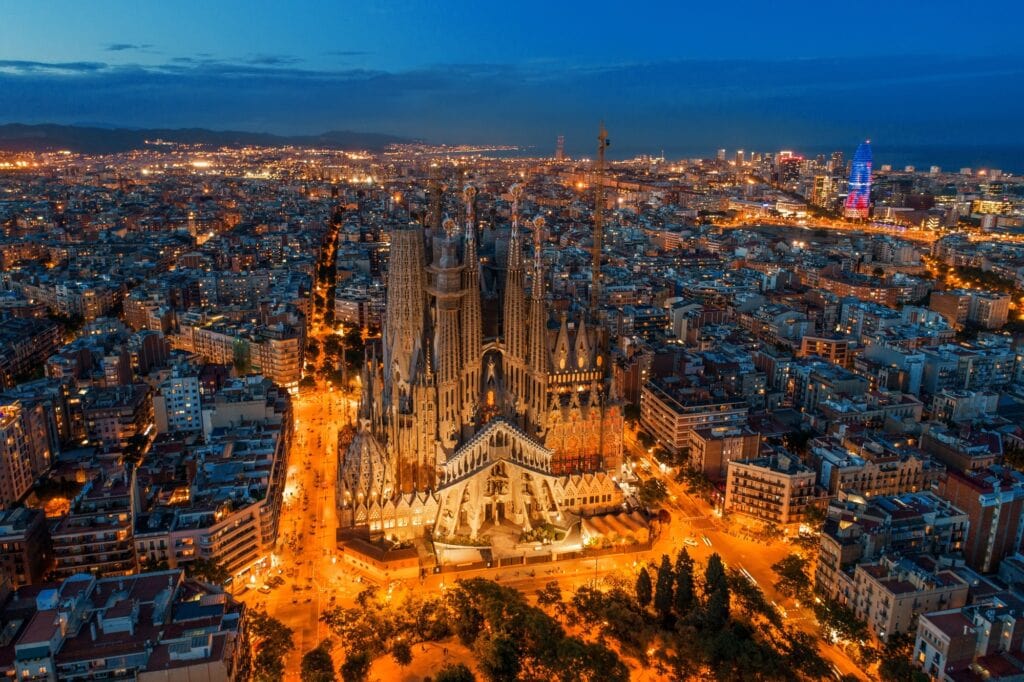
Sagrada Familia school
Gaudi was a man who believed in community and so he built a school for the worker’s children and the neighbourhood children. The school contains 3 classrooms, a hall and a chapel with three classrooms outside decorated with iron pergolas.
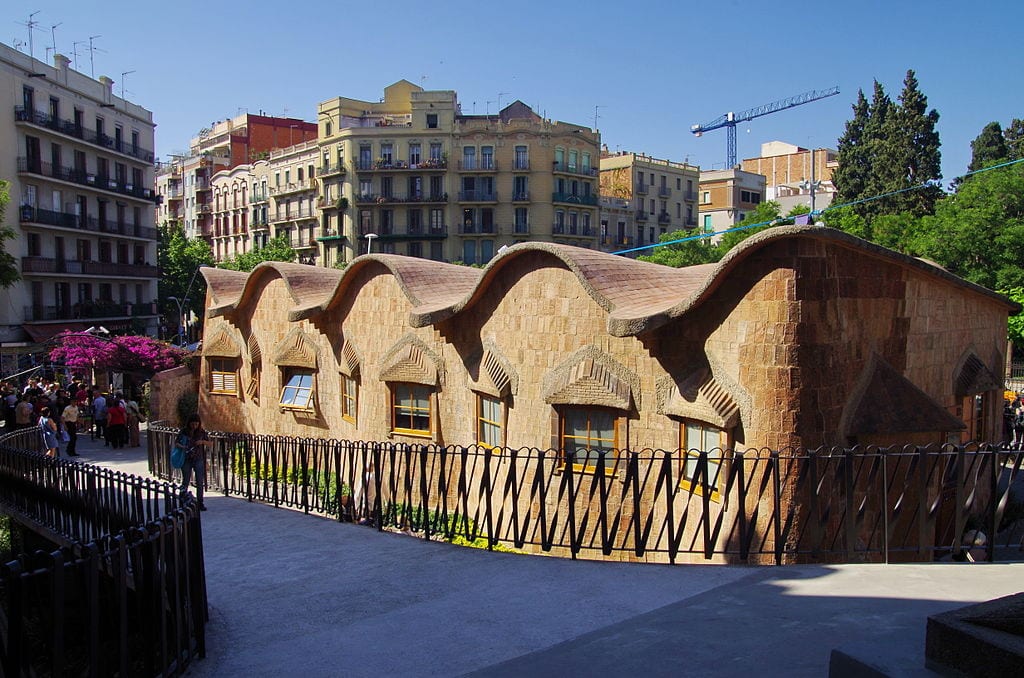
The school has gone through a lot since Gaudi built it. During the Spanish Civil War, it suffered major damage and the building was actually dismantled and then re-built later.
In 2002 the location of the school was needed for the ongoing building of the Sagrada so once again the school was dismantled and moved to the southern corner of the site.
Cascada Fountain at Parc de la Ciutadella
Gaudi didn’t have a major role in designing the Cascada Fountain but his influence can clearly be seen. The Fountain can be found in the Parc de la Ciutadella (Citadel Park). As a student, Gaudi was given the job of correcting the design for the fountain’s hydraulic and water tank systems.
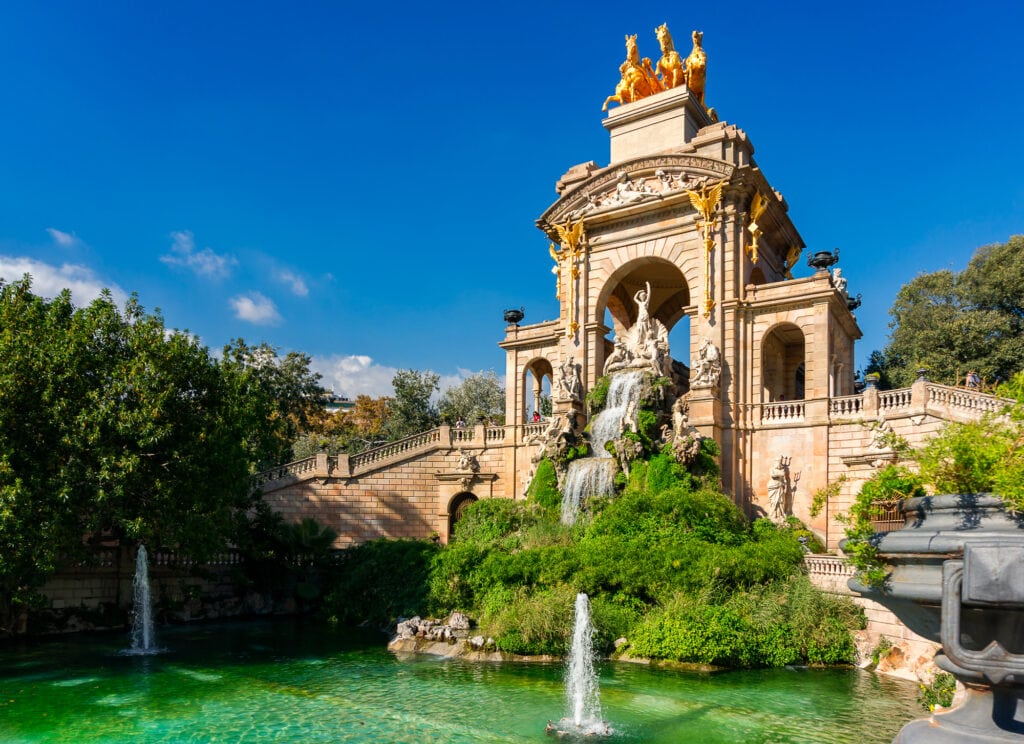
The actual design of the fountain bears a slight resemblance to the Trevi Fountain in Rome with the design incorporating waterspouts, stone-carved dragons and clams. A sculpture of Aurora in gold dominates the fountain riding her four horses that symbolize freedom and light.
Gaudi Street Lamps – Plaça Reial and Pla de Palau
When he was finished with his work on the Fountain the City commissioned him to design lampposts for the Royal Square (Placa Reial). Each lantern is topped by a dragon with a central post of a winged helmet. There is a slightly more simple version of the same design on Pla de Palau square nearby.
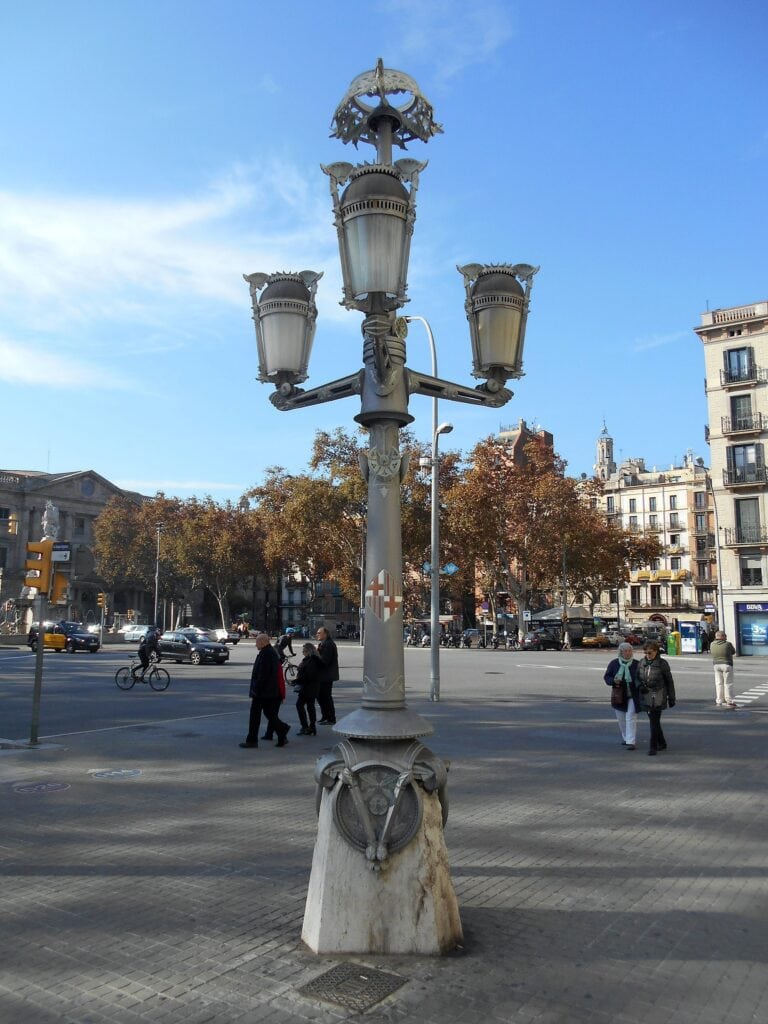
Torre Bellesguard (Casa Figueres)
The Bellesguard house was built by Gaudí between 1900 and 1909, with straight shapes and lines which was very unusual in his work. The house was inspired by the medieval castle of King Martin I the Human, the last Count of Barcelona, and the temporary residence of Benedict XIII, better known as Papa Luna.
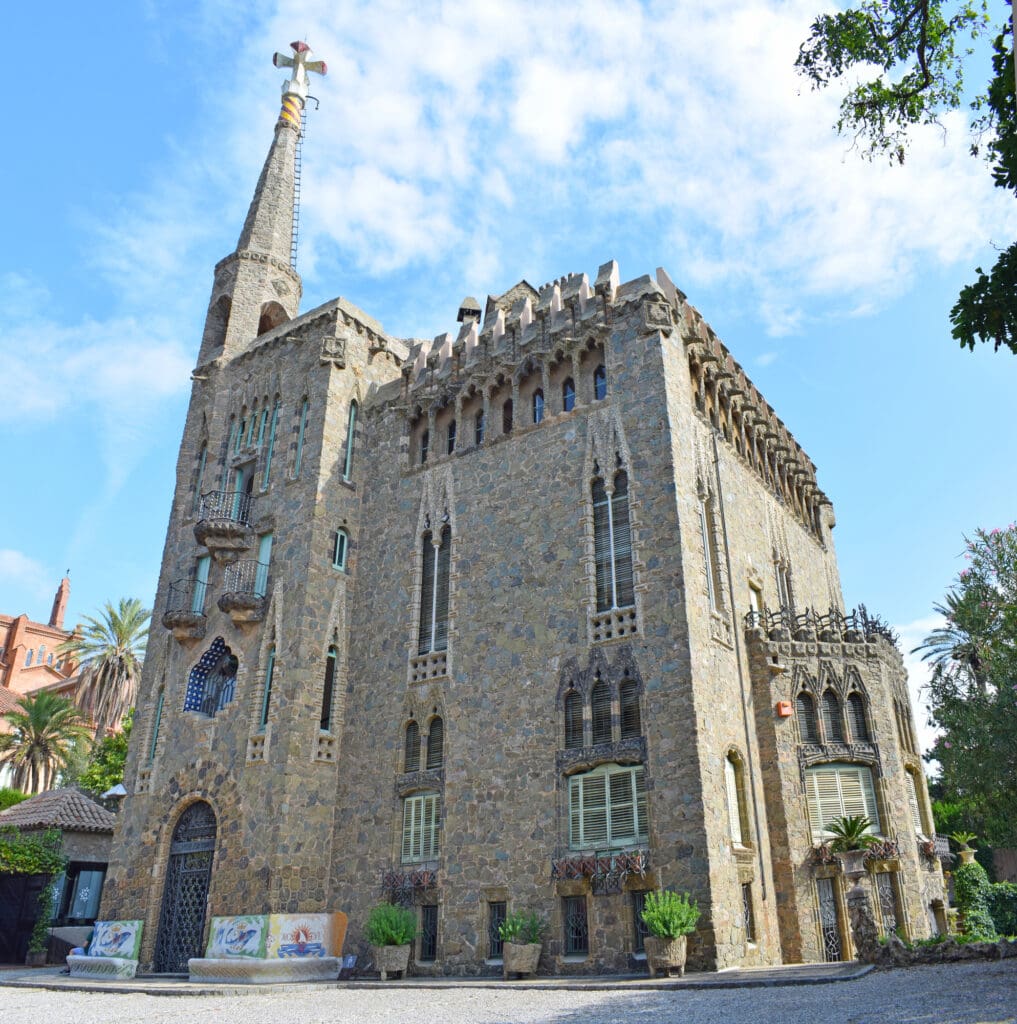
Gaudi also restored the medieval palace ruins that are now part of the mansion’s grounds. The house itself has white walls with iron details and lots of coloured glass. There is a Catalan arch built from overlaid bricks featured on the house.
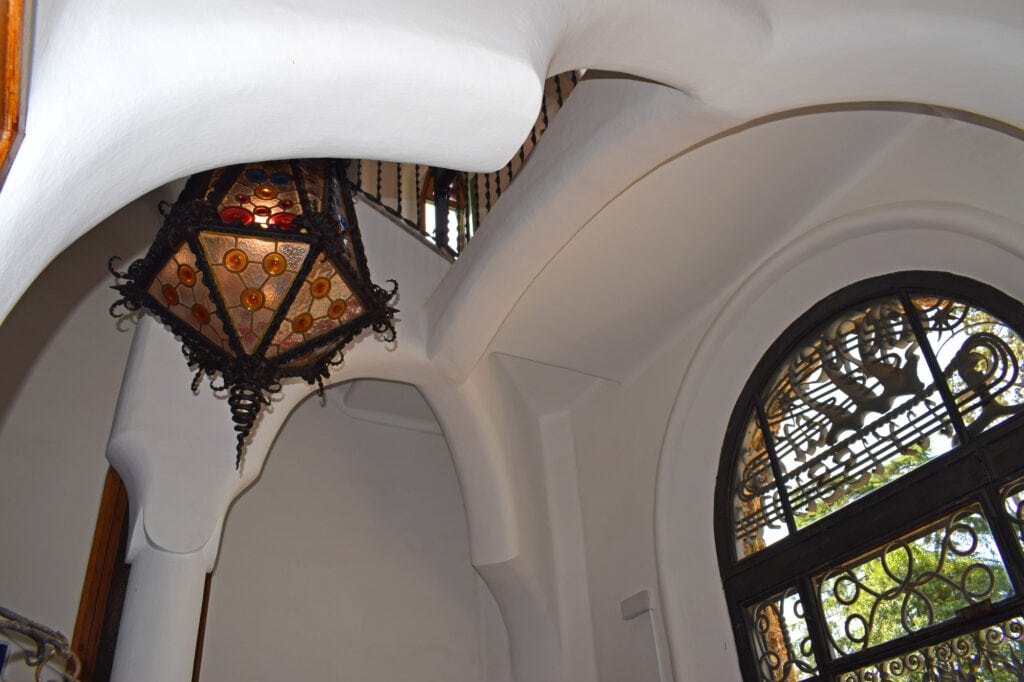
Street Tiles – Passeig de Gracia
Few people know it, but the very streets tiles of the Passeig de Gracia (the magnificent boulevard that is home to both the Casa Mila and the Casa Batllo) were designed by Gaudi. The architect created the tiles in 1904 and decorated them with sea snails and starfish. The city used them to pave the street in 1971.
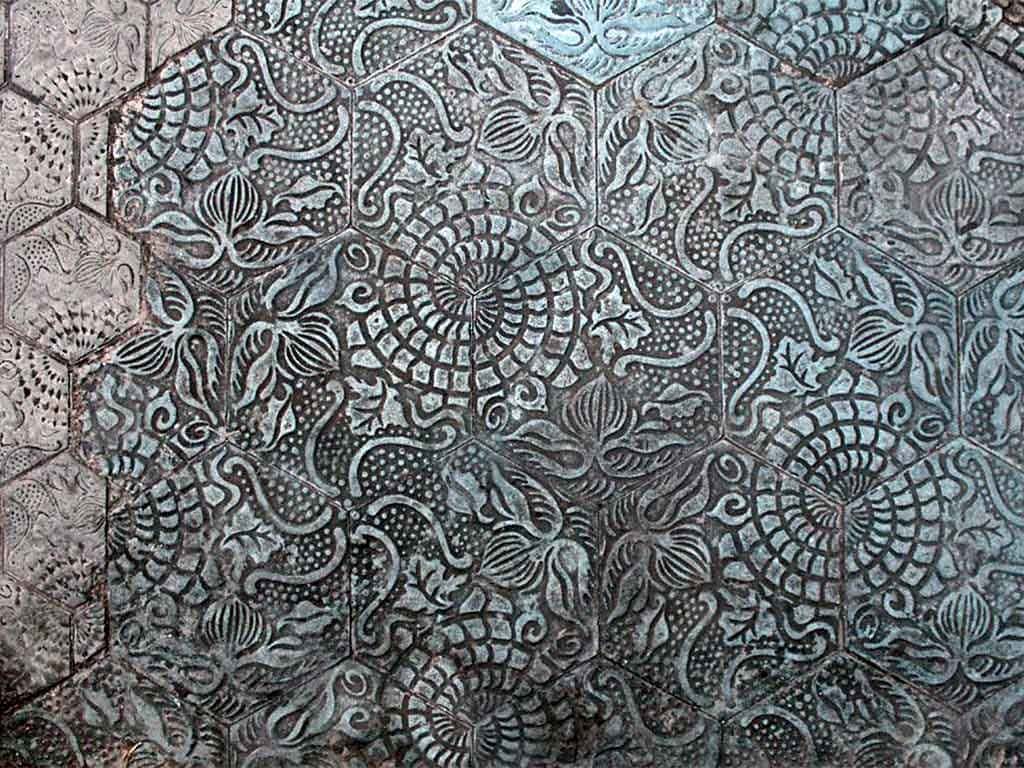
Gaudi designed this hexagonal panot (tile) which was an innovation that hadn’t been seen before. Unusually for Spanish tiles, there are no colours but the play of shadows on the tiles demonstrates Gaudi’s remarkable design abilities.
Gaudi Factory of Mataro
The factory of Mataró was the first of Gaudi’s work commissioned by the Sociedad Cooperativa Obrera Mataronense. This was a cotton bleaching factory created between 1878 and 1883. Here Gaudi used parabolic arches, that would later become very important in his work. The building was restored in 2008.
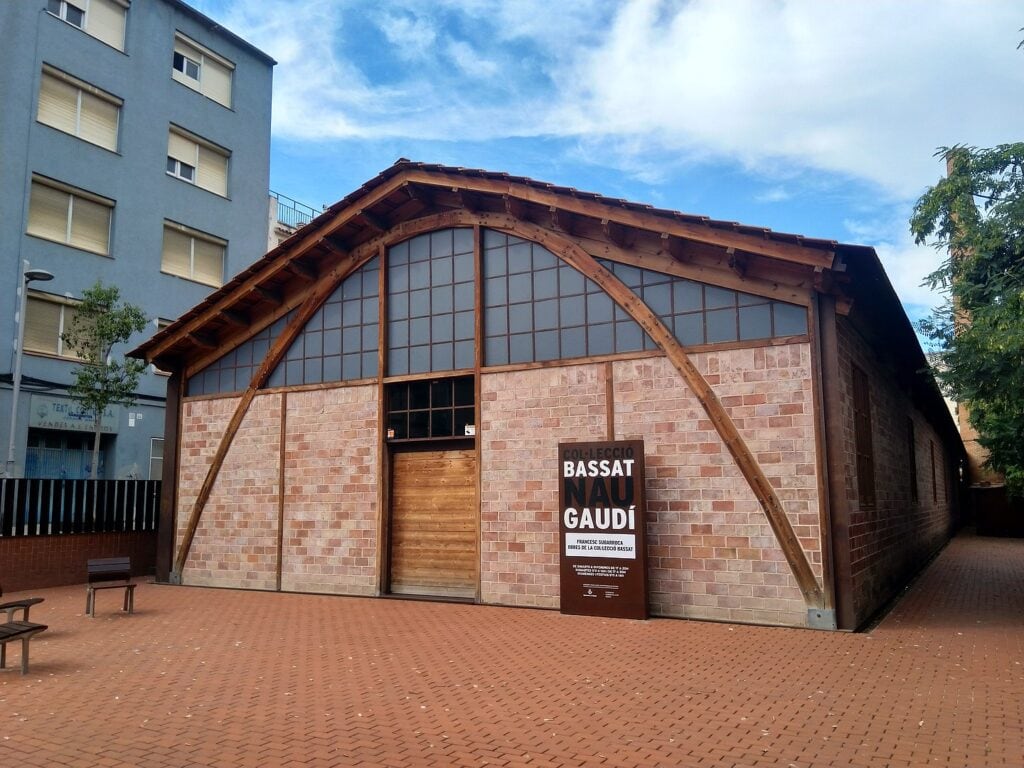
The building was declared a Cultural Property of National Interest by the Government of Catalonia in 1982 and since 2010 it has been the home of the Mataró Contemporary Art Museum Consortium, forming the exhibition space of the Bassat Collection.
Finca Miralles Gate
The Finca Miralles is long gone but the phenomenal gate designed by Gaudi remains. Know as the Portal Miralles it is one of the least known of Gaudi’s work. The gate was commissioned in 1901 to provide a beautiful entry point to his estate.
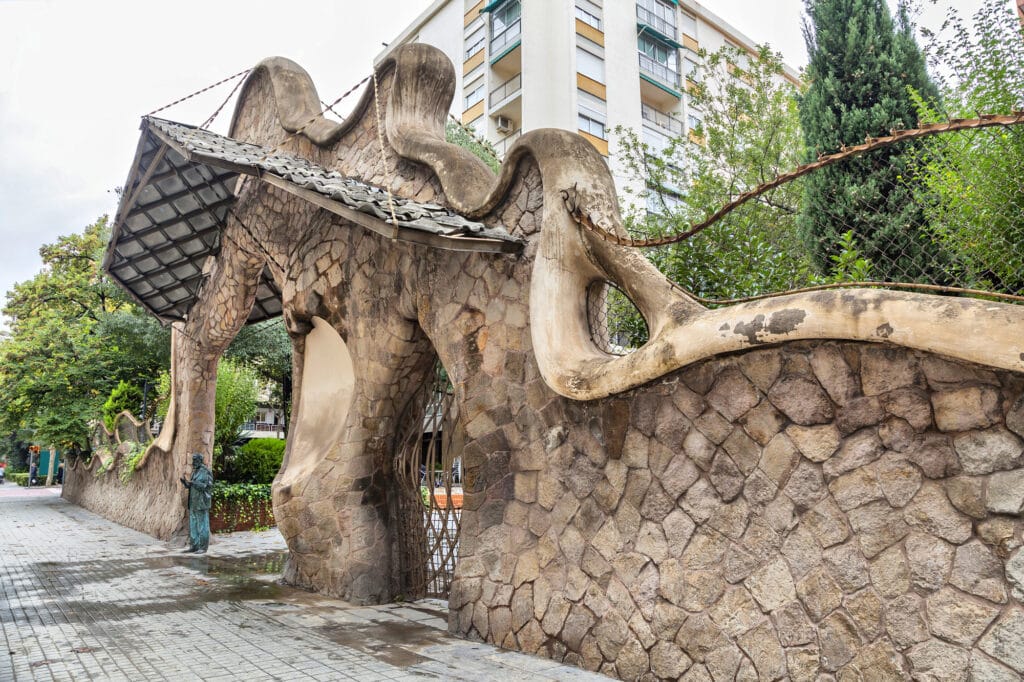
Restored in 2000 the gate is an opening in the wall that surrounded the estate, only a part of which, made from stone and finished in white trencadís, remains, with a metal grille that looks like a reptile’s skin. With a large trefoil arch and overhanging canopy, the gate is crowned by a three-dimensional cross made from wrought iron. At the side, there is a smaller gate that still has the original grille. There is a life-size statue of Gaudi under the gate.
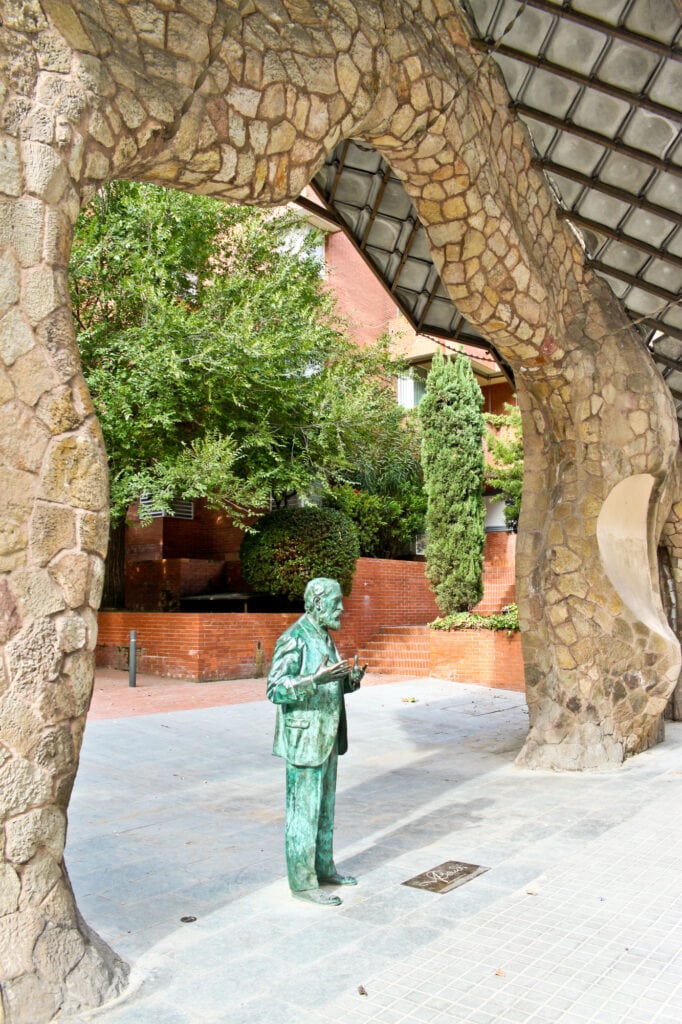
Güell Pavilions
Count Güell commissioned the Pavilions as he wanted Gaudi to re-design his estate and build a walled garden around it. Again Gaudi used an architectural style that combined the oriental and Mudéjar. The estate was left to the Spanish royal family and converted into a palace in 1918, after that the University of Barcelona purchased the buildings and in 1969 they were declared a Monument of National Historic and Artistic Interest.
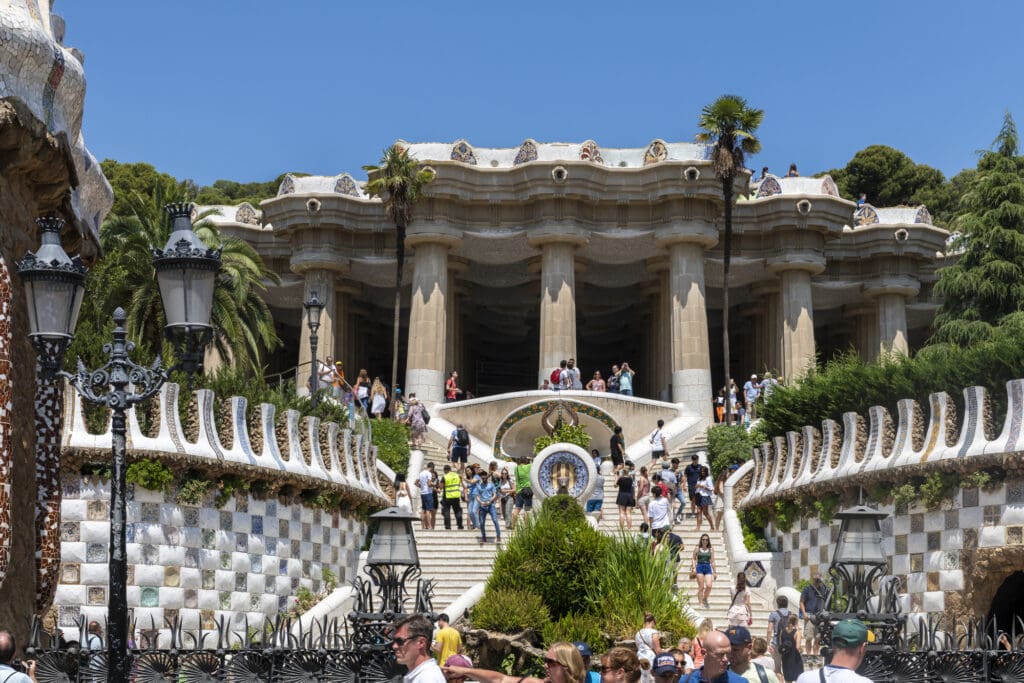
The buildings that remain on the estate included a lunge ring, gatehouses and a stable. The stables have the Gaudi characteristic vaulted ceilings and the other building are brick covered in coloured glass.
The centerpiece of this work is its iron gate, a masterful achievement showcasing Gaudí’s extensive expertise in iron forging techniques. Today, the most well-preserved element of the estate is its dragon. Gaudí paid homage to the Catalan poet Verdaguer and his epic poem “L’Atlàntida” by depicting Ladon, the dragon that guarded the entrance to the Garden of the Hesperides.

Park Guell
Park Güell is a public park of over 17 hectares and is a UNESCO Heritage Site that dazzles you with its natural beauty. It was built by Gaudi as his personal estate and sits high on Carmel Hill with breathtaking views of the sea.
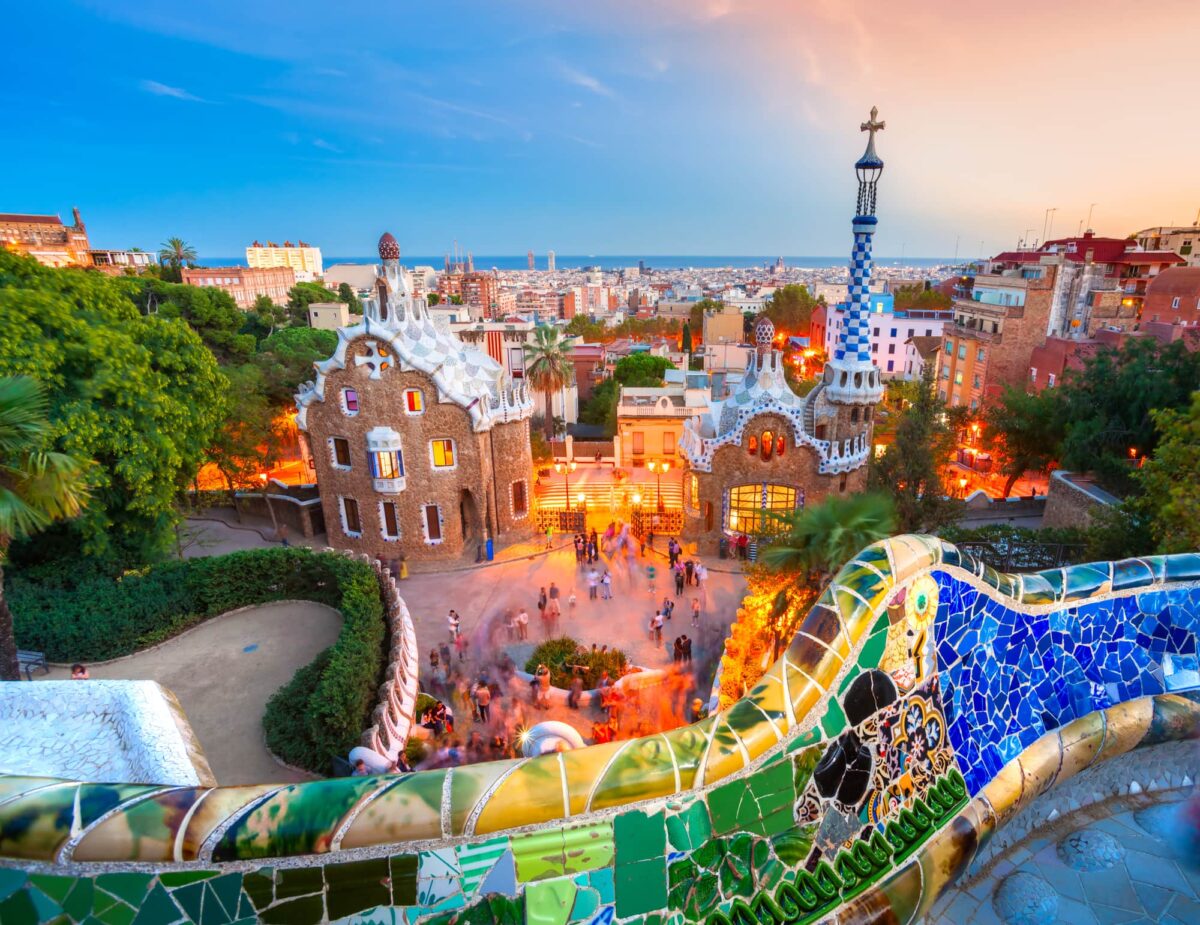
Gaudi never finished the estate but today it is an iconic Gaudi site featuring stunning mosaics, sculptures, benches and resting spots. The park contains two large areas which include the UNESCO world heritage site and adjacent woodland. Access to the park is closely watched to prevent tourist overcrowding.
Gaudi bank Barcelona the corrugated ceramic bank found at Park Güell Square is undoubtedly one of the masterpieces of modernism worldwide. Antoni Gaudí made brittle ceramic “trancadís” between 1900 and 1903.The bank holds 72 flowers, most of which have five petals.
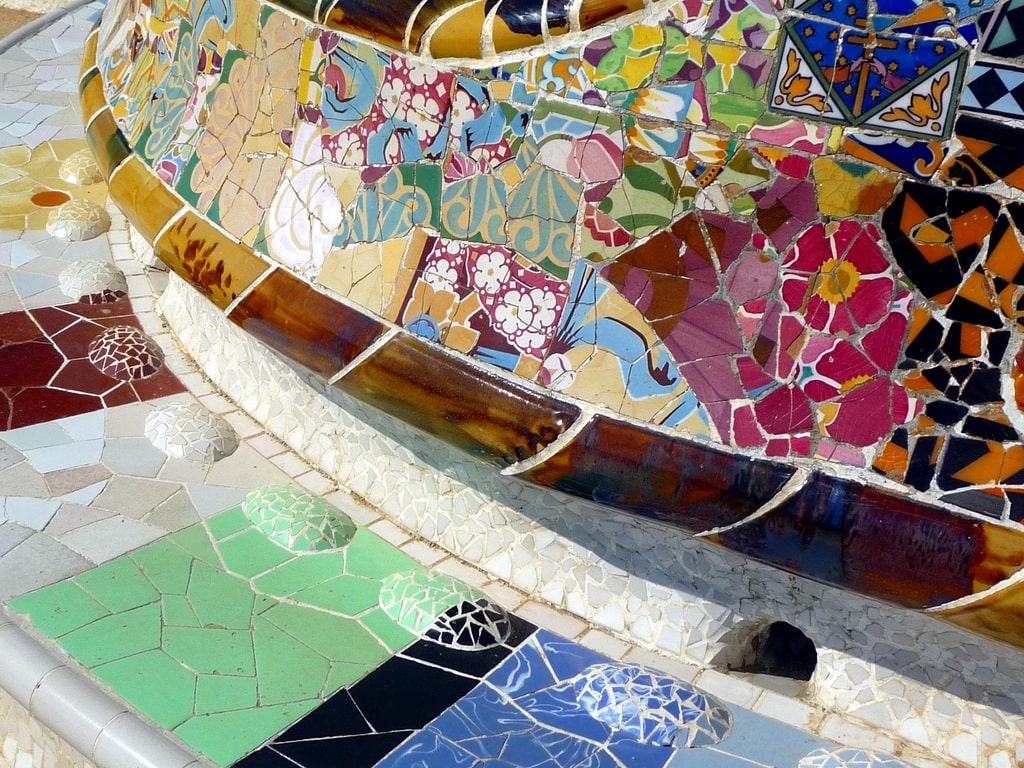
Casa Batlló
Josep Batlló bought the house in 1904 and commissioned Gaudi to redesign it completely By 1906 the house was famous for turning every architectural convention on its head and it won the award for “One of the best three buildings of the year”.
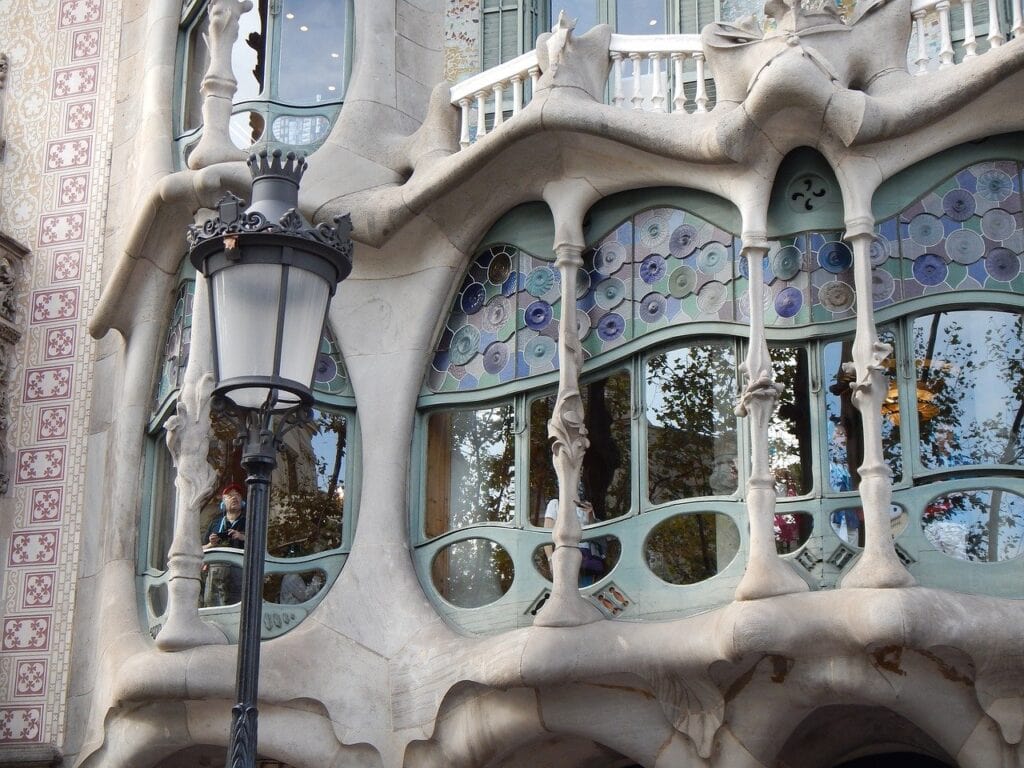
Loved by Goths around the world the pillars on the front of the building were made to look like bones and the roof replicated the scales of a dragon. This incredible building has become known locally as the house of bones and the house of the dragon.
The facade incorporates found objects, stones, stained glass, and ceramics creating a sparkling building that makes you smile in appreciation. This building is a celebration of Gaudi’s work bringing together art, life, movement, and joy.
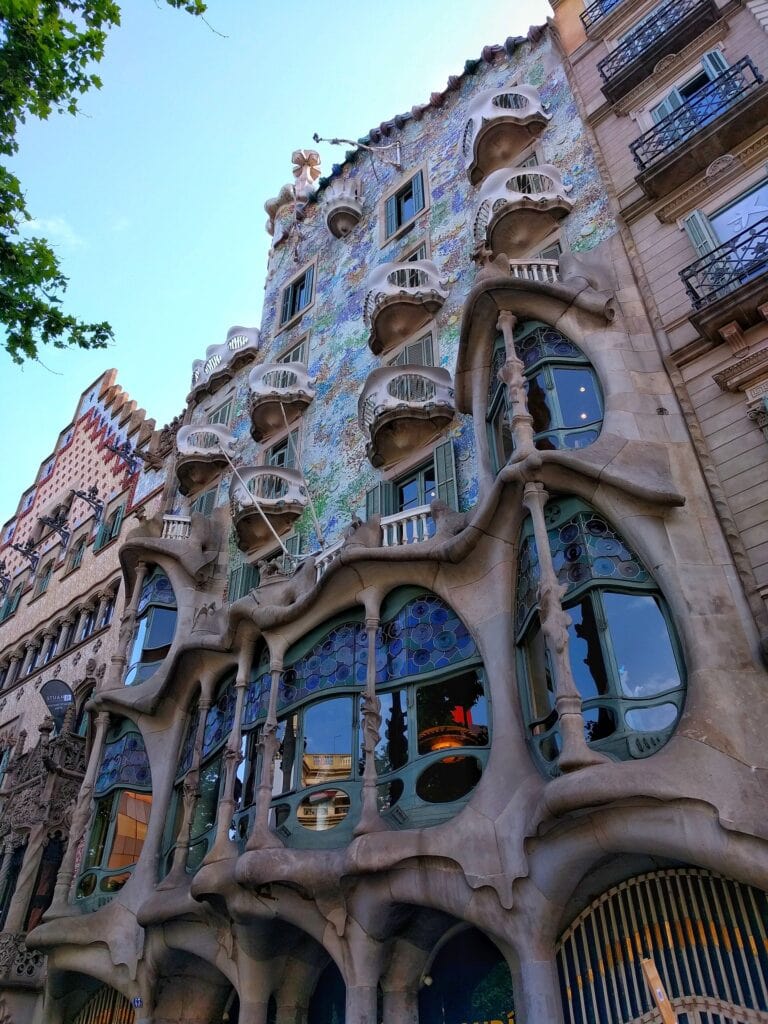
Church of Colònia Güell – The Crypt
Colonia Güell was a textile company built by Eusebio Güell in his country estate «Can Soler de la Torre», near Barcelona. Güell was a social innovator and when the manufacturing industry began to outstrip the land available in Barcelona he and others began to build outside the City. They called these areas worker colonies. Güell wanted his colony to comprise the factory, schools, housing, hospitals, markets and shops for the workers. He commissioned Gaudi to build the Church for his colony. Sadly due to financial issues, the complex was never finished and the Church was unfinished except for the entrance and the crypt.
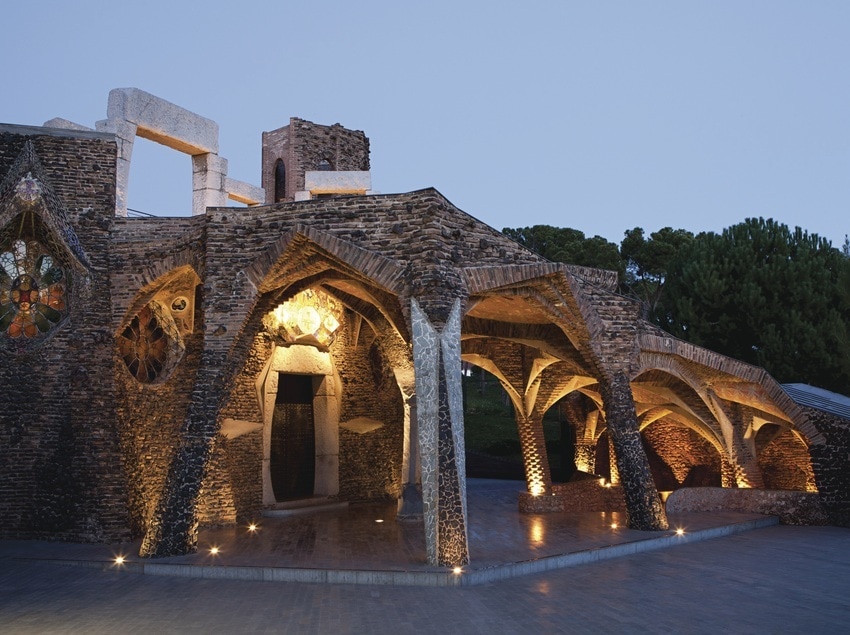
The Church was adapted to fit the hill’s slope where the colony was developed. Unfinished this is considered one of Gaudi’s best buildings. The only portion of the Church fully completed is that of the Crypt which appears to melt into the surroundings. Within the Church are 22 stained glass windows that allow light to penetrate into the darkness of the Church.
In 2005 the Colonia Güell was declared a UNESCO World Heritage site alongside six other masterpieces by Antoni Gaudí. Despite this, it remains relatively unknown to the public and attracts nowhere near the same attention as its counterparts in Barcelona.
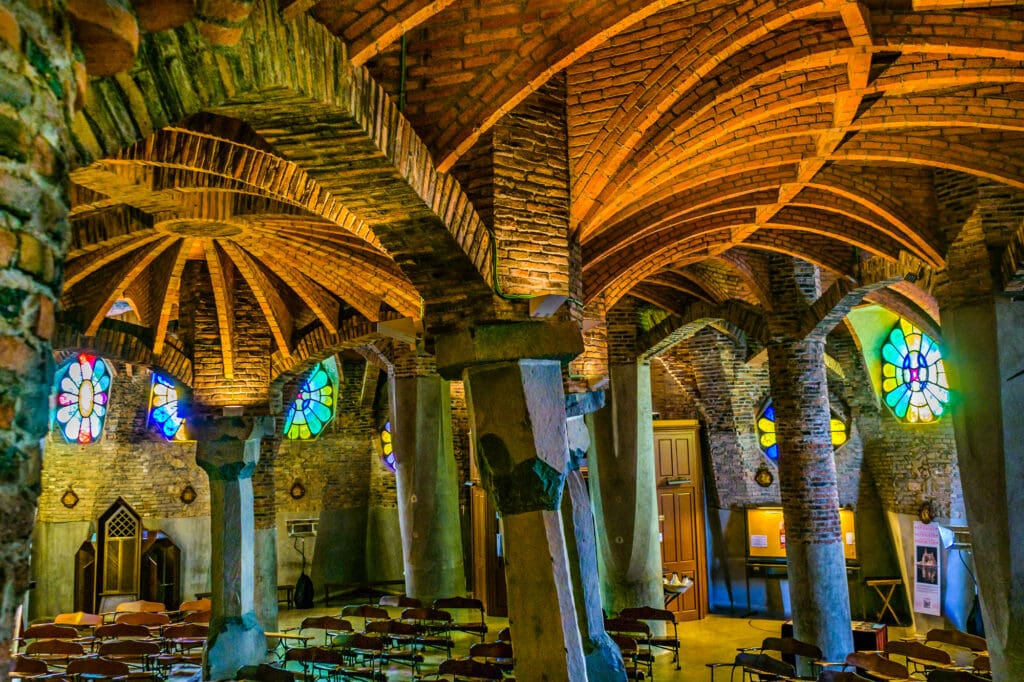
Church Sant Pacià – Mosaic of Gaudí
The mosaic decorating the floor of this church is made of marble and stoneware tiles of various colours in geometric shapes: there are floral motifs and representations of the Greek letters Alpha and Omega, symbols of the beginning and end according to the Apocalypse. Although Gaudi did not design and build the Church he was commissioned to create the incredible mosaic floor. During the Spanish Civil War, the church was burned – Gaudi’s floor was restored in 1988.
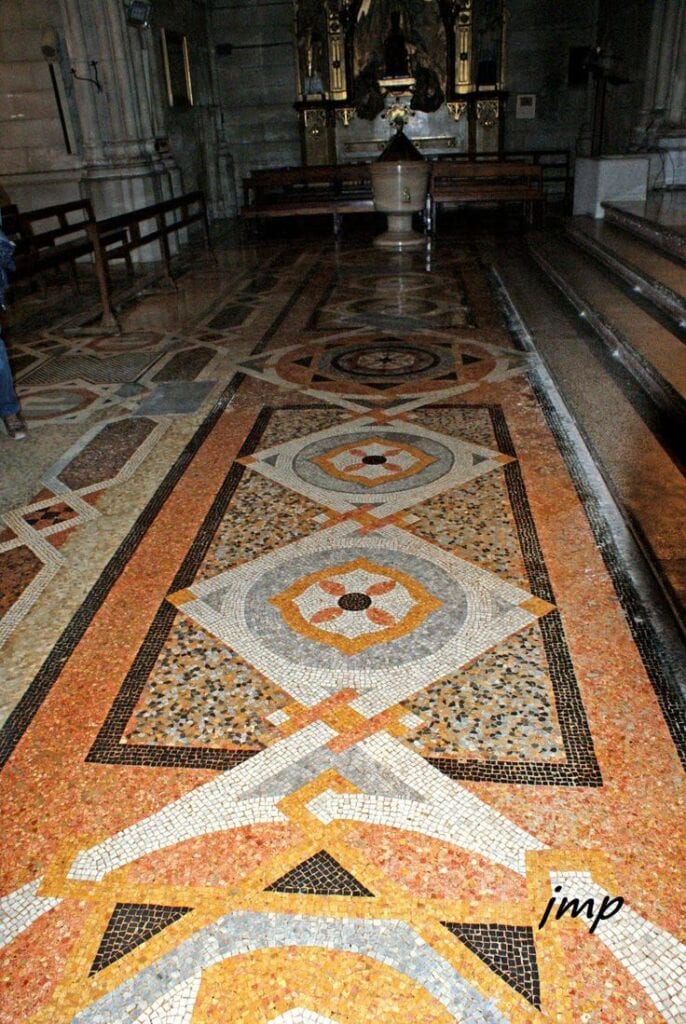
Gaudi Museums
When visiting Barcelona to find Gaudi’s work you can visit one of the 4 museums that provide a deeper understanding of the man and his work.
Gaudi House Museum
This romantic peach-coloured mansion was actually designed by Gaudi’s frequent collaborator, Francesc The house was commissioned by Guell, and built by Gaudi’s friend Berenguer it was designed to attract buyers to invest in the entrepreneur’s vision of a garden city. That didn’t work so well and in the end, Gaudi bought the house himself and lived there with his father and niece.
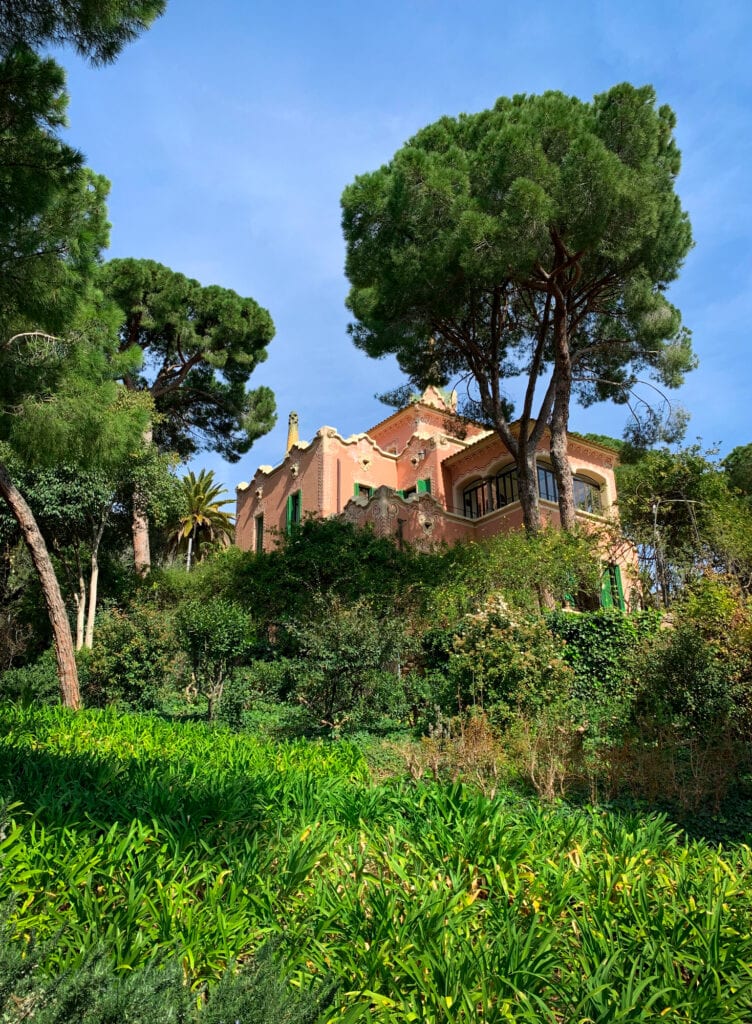
After his family died Gaudi moved to the Sagrada Familia to finish his great work and this house was later restored as the Gaudi House Museum. The house showcases some of Gaudi’s furniture designs and gives a peek into his life.
Gaudi Exhibition Centre
This is a very modern look at the genius of Gaudi with a 180º video introduction, an interactive augmented reality exhibit and lots of audiovisual and multimedia content. You can actually experience the virtual reality that takes you back through time with Gaudi as your guide.
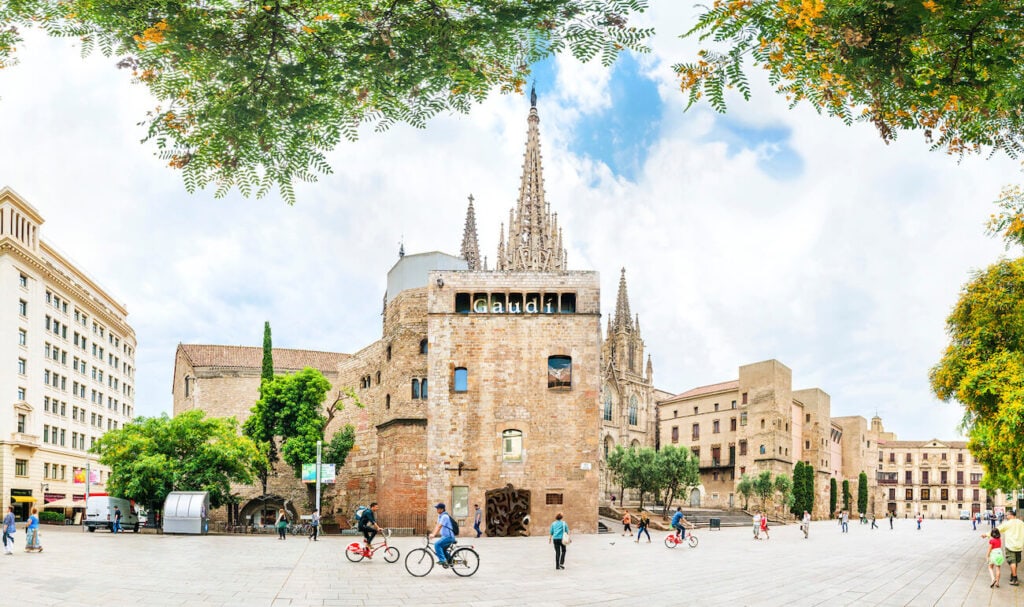
Gaudi Experience
The Gaudi Experience is another museum with high tech exhibits. Here you can see the New York Hotel that Gaudi designed and was never built. There are interactive walls and a 4D film with surround sound and moving seats that highlights Gaudi’s achievements.
National Museum of Catalan Art
While this museum doesn’t focus on Gaudi it does feature over 1000 years of Catalan art and here you will find a treasure trove of Catalonian creative works. The Museum houses work by Picasso, Casa and some Gaudi furniture pieces.
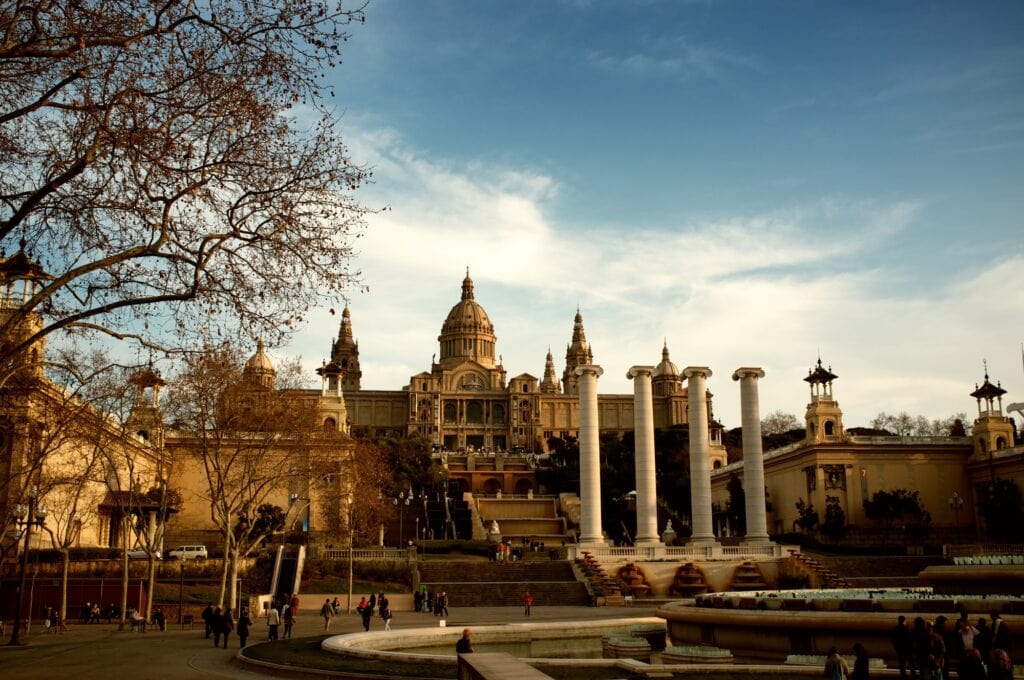
Antoni Gaudí buildings are the most famous buildings in Barcelona and all of these Gaudi buildings are worth seeking out. Barcelona is a city that offers a variety of exciting activities and attractions, but no visit would be complete without exploring the incredible works of Antoni Gaudi. With his unique style, he has left an unmistakable mark on the city. From La Sagrada Família to Park Güell and Casa Batlló, there’s something for everyone to enjoy when looking for Antoni Gaudi in Barcelona. So take some time to explore this amazing artist’s work during your next visit!
You might also like some of these articles on visiting Spain:
The Ultimate Guide to Spanish Olive Oil
What is Semana Santa? Celebrating Holy Week in Spain
13 Magical Things to Do in Seville
7 Less Touristy Things to do in Malaga, Spain: by a Local
